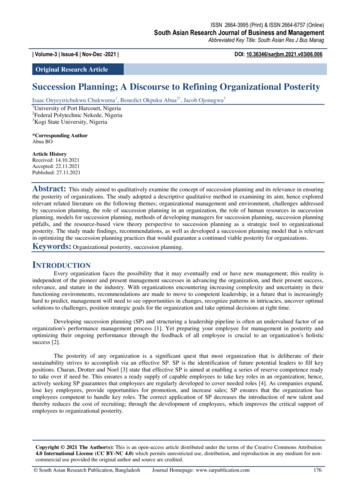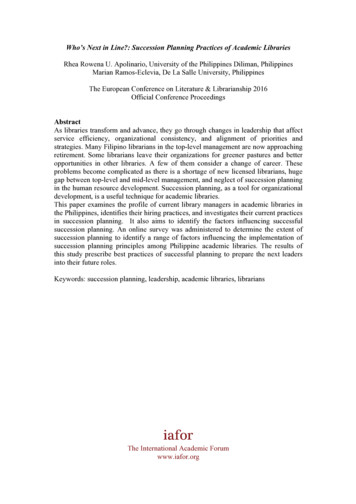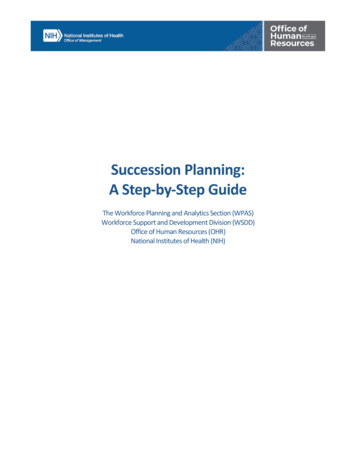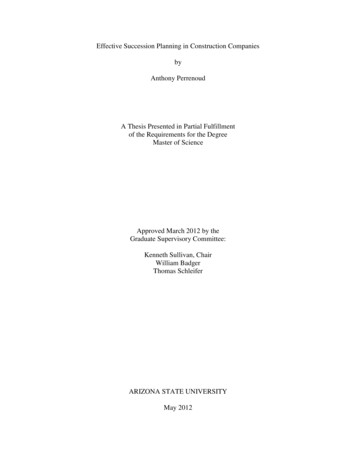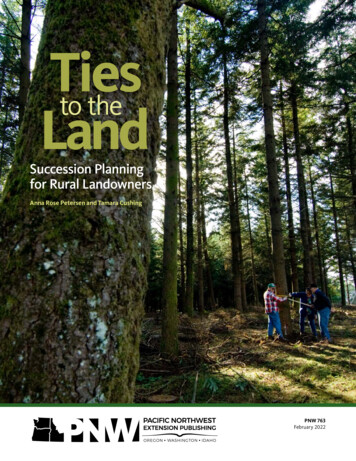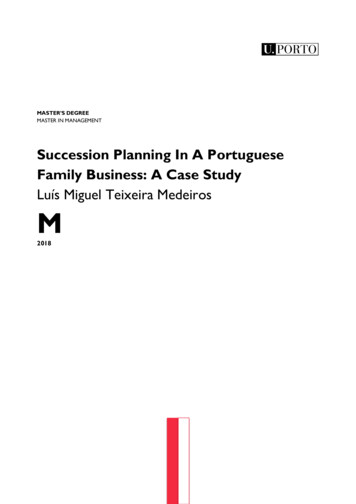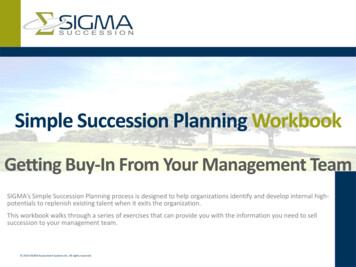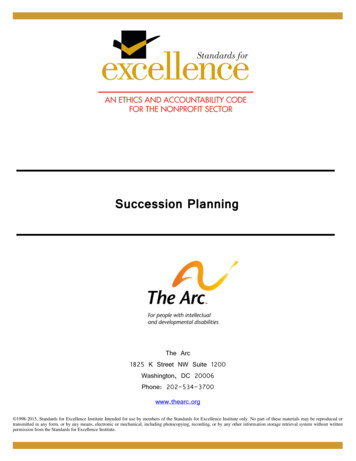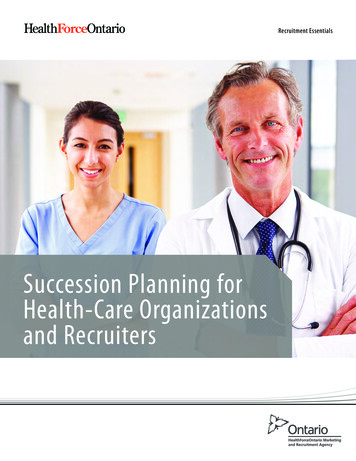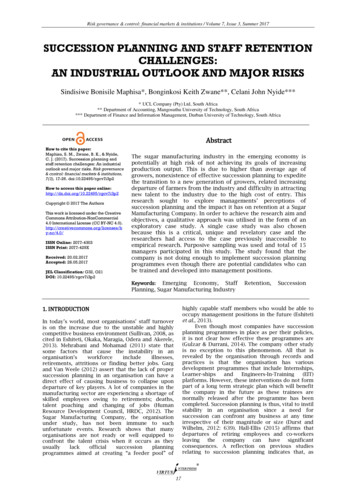
Transcription
Risk governance & control: financial markets & institutions / Volume 7, Issue 3, Summer 2017SUCCESSION PLANNING AND STAFF RETENTIONCHALLENGES:AN INDUSTRIAL OUTLOOK AND MAJOR RISKSSindisiwe Bonisile Maphisa*, Bonginkosi Keith Zwane**, Celani John Nyide**** UCL Company (Pty) Ltd, South Africa** Department of Accounting, Mangosuthu University of Technology, South Africa*** Department of Finance and Information Management, Durban University of Technology, South AfricaAbstractHow to cite this paper:Maphisa, S. M., Zwane, B. K., & Nyide,C. J. (2017). Succession planning andstaff retention challenges: An industrialoutlook and major risks. Risk governance& control: financial markets & institutions,7(3), 17-26. doi:10.22495/rgcv7i3p2How to access this paper ht 2017 The AuthorsThis work is licensed under the CreativeCommons Attribution-NonCommercial4.0 International License (CC BY-NC /ISSN Online: 2077-4303ISSN Print: 2077-429XReceived: 20.02.2017Accepted: 28.05.2017JEL Classification: G32, O21DOI: 10.22495/rgcv7i3p2The sugar manufacturing industry in the emerging economy ispotentially at high risk of not achieving its goals of increasingproduction output. This is due to higher than average age ofgrowers, nonexistence of effective succession planning to expeditethe transition to a new generation of growers, related increasingdeparture of farmers from the industry and difficulty in attractingnew talent to the industry due to the high cost of entry. Thisresearch sought to explore managements’ perceptions ofsuccession planning and the impact it has on retention at a SugarManufacturing Company. In order to achieve the research aim andobjectives, a qualitative approach was utilised in the form of anexploratory case study. A single case study was also chosenbecause this is a critical, unique and revelatory case and theresearchers had access to the case previously inaccessible toempirical research. Purposive sampling was used and total of 15managers participated in this study. The study found that thecompany is not doing enough to implement succession planningprogrammes even though there are potential candidates who canbe trained and developed into management positions.Keywords: Emerging Economy, StaffPlanning, Sugar Manufacturing IndustryRetention,Successionhighly capable staff members who would be able tooccupy management positions in the future (Eshitetiet al., 2013).Even though most companies have successionplanning programmes in place as per their policies,it is not clear how effective these programmes are(Gulzar & Durrani, 2014). The company other studyis no exception to this phenomenon. All that isrevealed by the organisation through records andpractices is that the organisation has variousdevelopment programmes that include EIT)platforms. However, these interventions do not formpart of a long term strategic plan which will benefitthe company in the future as these trainees arenormally released after the programme has beencompleted. Succession planning is thus, vital to instilstability in an organisation since a need forsuccession can confront any business at any timeirrespective of their magnitude or size (Durst andWilhelm, 2012: 639). Hall-Ellis (2015) affirms thatdepartures of retiring employees and co-workersleaving the company can have significantconsequences. A reflection on previous studiesrelating to succession planning indicates that, as1. INTRODUCTIONIn today’s world, most organisations’ staff turnoveris on the increase due to the unstable and highlycompetitive business environment (Sullivan, 2008, ascited in Eshiteti, Okaka, Maragia, Odera and Akerele,2013). Mehrabani and Mohamad (2011) state thatsome factors that cause the instability in ments, attritions or finding better jobs. Gargand Van Weele (2012) assert that the lack of propersuccession planning in an organisation can have adirect effect of causing business to collapse upondeparture of key players. A lot of companies in themanufacturing sector are experiencing a shortage ofskilled employees owing to retirements; deaths,talent poaching and changing of jobs (HumanResource Development Council, HRDC, 2012). TheSugar Manufacturing Company, the organisationunder study, has not been immune to suchunfortunate events. Research shows that manyorganisations are not ready or well equipped toconfront the talent crisis when it occurs as s aimed at creating “a feeder pool” of17
Risk governance & control: financial markets & institutions / Volume 7, Issue 3, Summer 2017organisational circumstances changes throughbusiness growth, promotions and resignations ofkey staff, proactive succession planning will providea guarantee that the company will have a backuppool of talent ready to fulfil new roles (Mathur,2011).The Sugar Manufacturing Company beinginvestigated has recently lost a number of keyemployees in managerial and other critical positionsdue to deaths, retirements, dismissals andresignations. This in turn has forced the companyto, at times, reinstate retired employees or hireexternally due to lack of suitable replacements frominternal workforce. This is a persistent problemwithin the sugar manufacturing industry. Accordingto Blazevic (2013), the sugar industry is potentiallyat high risk of not achieving its goals of increasingproduction output since there is a related increasingdeparture of farmers from the industry d early retirement by managers at alllevels and failure by the organisation to fill thevacant positions created by early retirement is acause for concern at this company under study.Research has been conducted on successionplanning in the past, however, minimum researchhas been done in the sugar manufacturing industry(Mathur & Agarwal, 2013).The aim of this study is to exploremanagement’s perceptions regarding successionplanning at a Sugar Manufacturing Company and theimpact succession planning has on staff retention.Objectives of the study: To determine the perceptions of employees atmanagement level on the current successionplanning practices using a case of a SugarManufacturing Company. To determine the factors hindering successfulimplementation of succession planning using a caseof a Sugar Manufacturing Company.encouragement of individual advancement”.According to King (2005), as cited in Garg andWeele (2012), succession planning is actually apractice that warrants uninterrupted effectivefunctioning of an organisation by instituting aprocess that assists in developing and replacing keystaff members over time. Mathur (2011) is inagreement with these writers stating that successionplanning system is intended to ensure that skilledand talented employees are prepared to take overeach key role in the event of sudden loss ofefficiency created by retirements, death, seriousillnesses or promotions. The aforementioned authorfurther explains succession planning as some formof internal recruitment where highly capableemployees have their abilities, skills and knowledgedeveloped to prepare them to fill-in morechallenging and exciting roles.Staff Retention“Turnover is very costly to the organisation in termsof financial bearings, its implications on employeemorale and customer satisfaction” (Eshiteti et al.,2013). Tunje (2014), thus, refer to staff retention asthe capability of a company to keep its employeesfrom leaving the company while reducing staffturnover. Schroeder, Goldstein, and Rungtusanatham(2013) state that employee retention and lowemployee turnover assist in driving productionefficiency and customer value. Chitsaz-Isfahani andBoustani (2014) on the other hand state that“employee retention is commonly considered tomean the ability to maintain a stable humanresource”. The above mentioned authors furtherrefer to employee retention as all that energyexerted by the organisation to alleviate the chancesof an individual to remain longer within thecompany.Succession Planning Practices2. LITERATURE REVIEWMathur (2011) concedes that finding suitablereplacements is a process that requires complexdesign and strategy. The author further suggests athree phase model of succession planning whichcompanies use to characterise their succession anddevelopment practises as follows:- Phase I - Identify key roles for succession orreplacement planning and define the competenciesand motivational profile required to undertake thoseroles.- Phase II - Assess people against these criteria with a future orientation.- Phase III - Identify pools of talent that couldpotentially fill and perform highly in key roles anddevelop employees to be ready for advancement intokey.Rothwell (2002) as cited in Mehrabani andMohamad (2013), affirm that there are othercommon practices that can assist in successfullyachieving effective succession planning efforts.These include: Clarifying the aim and the desired results ofthe effort. Determining the requirements of the currentperformance. Measuring the performance and determiningthe performance that might be needed in the future.Definition of TermsIn order to get a better insight to this study, it isimportant to define the two key terms that areapplicable: succession planning and staff retention.Succession PlanningMehrabani and Mohamad (2011) suggests that thekey to the future success of an organisation isdetermined by how it assesses and understands thevalue of the people it has and what resources it willneed in the future. The aforementioned authorsfurther state that the one human resource toolwhich can assist to determine the current and futureneeds of the organisation is succession planning.Collins (2009) as referred by Adewale, Abolaji andKolade (2011) views succession planning as apractice that can offer seamless leadershiptransition throughout the company. Rothwell (2011)as cited in Garg and Weele (2012) supports the aboveauthors stating that “succession planning is adeliberate and systematic effort by an organisationto ensure leadership continuity in key positions,retention and development of intellectual andknowledgecapitalforthefuture,and18
Risk governance & control: financial markets & institutions / Volume 7, Issue 3, Summer 2017predecessor decides to step down The second component involves changingmanagement style – The succession process requiresan incumbent to be taught how to lead and manage,the predecessor must at times forgo their personalleadership and management style and become theteacher and mentor for the candidate. The third component is successor training anddevelopment - The success of the potentialdescendent lies in getting the appropriate leadershipdevelopment training. The fourth and final component is selectingthe successor – There are many factors to considerwhen qualifying an individual to lead and manage,these include knowledge, skills, abilities, motivation,ambition, temperament, formal education andexperience.The above can be further simplified as in Fig 1– Main components to leadership successionplanning. Assessing the potential, establishing a way tonarrow the gaps, following up and documentingcompetence. Making and maintaining rewards fordeveloping people, evaluating results and leadingfrom the front (Mehrabani & Mohamad, 2013).Main Components of Succession PlanningStadler (2011) acclaims that succession planning andmanagement should be in line with theorganisation’s strategic vision and objectives.Mutunga and Gachunga (2013) suggest four maincomponents to Leadership Succession Planning: The first component is identifying thepotential successor - this is the process of selectinga suitable candidate to take over in the event that akey leadership position becomes vacant. Thisinvolves identifying at least one or preferable morethan one candidate who should begin the successionprocess as soon as possible and long before theFigure 1. Main components to leadership succession planningIdentifying potential SuccessorChanging management styleSuccessor training and developmentSelecting successorSource: Adopted from Mutunga and Gachunga (2013)Stadler (2011) affirms that employees with highjob satisfaction are normally committed to thecompany as they believe the company has greatfuture for them and in the end will care about theircontribution to the organisation. Committedemployees are more likely to excel in their jobs,remain in employment longer and resist job offers,subsequently increasing retention rates andproductivity (Stadler, 2011). Oladapo (2014) assertsthat successful retention practices begin with goodhiring practices since competent and motivatedpeople will stay longer. Branham (2005) as quoted inOladopo (2014) ascertain that poor hiring practicesescalates turnover in two ways: new recruits that areincompatible and disorientated tend to leavequickly; experienced staff, on the other hand, canbecome highly frustrated at the revolving door ofnewcomers that places a continual burden on theirtime and performance.The influence of succession planning on staffretentionImna and Hassan (2015) affirm that one of the maincritical issues companies face today, particularly inthe sugar manufacturing industry, is to retain theirworkforce. Das and Baruah (2013) points out thatthe weathering life-long success of an organisationrest upon retaining of the key role players. Gulzarand Durrani (2014) assert that organisations need toinvest in human capital, however, this call for properplanning.Gulzar and Durrani (2014) furtherstipulate that appropriate talent managementpolicies and practices that exhibit commitment toemployee development produce more committedstaff members within the organisation and reducestaff turnover. Tunje (2014: 61) asserts that forsuccession planning to be implemented in an effortto retain employees, focus needs to be laid on ned author emphasised that the existingsuccession planning practices should always lead toemployee retention and therefore, consciousdecisions need to be made when promoting talentedemployees. The outcomes of the research done byEshiteti et al. (2013) indicate that successionplanning programmes enable employee developmentopportunities and job satisfaction which in turn hasa great influence on staff retention.Factors affecting succession planningMutunga and Gachunga (2013) views successionplanning as a unique process where one-size-fits-allapproach is simply not appropriate. Mathur (2011:55) adds that there are several factors which affectthe process of succession planning. These factors donot only affect the productivity, reputation, brandimage and morale of employees but affect the19
Risk governance & control: financial markets & institutions / Volume 7, Issue 3, Summer ion plan, size of company and leadershipdevelopment. These are discussed as follows: Succession plan: It offers a blueprint for thegrowth of the organisation and is vital to theprolonged existence of any business. Executing asuccession strategy can be daunting as it is not aone-size-fits-all but needs to be customized for eachparticular organisation. It should be considered thatwhat works well for one company might not workfor the other (Mathur, 2011). The important factorsthat assist to guide organisation in undertakingsuccession planning include having a strong humanresources (HR) that will take succession planningpractices very seriously (Mehrabani & Mohamad,2011). Succession planning as part of RecruitmentPlan, Training Plan and Career Growth ManagementPlan with Performance Appraisal and HRMS toolsassists to ensure that the right kind of people inright numbers at the right time is available to help insustaining continuity of strength and vitality of anorganisation (Mateso, 2010). Size of company: According to Mathur (2011:55),a large size company must ensure that it has a largerpool of potential successors to choose from. Theorganisation may in the beginning identify nce and later make a decision when it iscloser to time for them to take over. With smallerorganisations, however, designating a replacementmay be more challenging. The organisation mighthave a shortage of employees prepared to take over,and there may be a need to employ someoneprecisely for the position, or hire employees basednot only on how qualified they are for the job, buton how qualified they are to move up to higher-levelpositions (Mateso, 2010). Leadership development: Successful successionplanning does not only depend on identifyingsuitable candidates to take over, but mentoringpotential successors to ensure they are wellequipped (Koranteng, 2014). The biggest mistakethat most companies do, is simply replacing keyexecutives instead of assessing all employees andidentifying and training any person with potential tomove up (Mathur, 2011). Organisations withleadership development programmes in placenormally will have a much larger feeder ofsuccessors from which to choose from, and who willbe better trained to take on a greater variety of roles.method has been adopted in this study. This type ofcase study is used to explore those situations inwhich the intervention being evaluated has no clear,single set of outcomes (Yin, 2012). The use of casestudy as a research methodology to collect data isappropriate for this study because it is a means toprovide rich drawings, descriptions, considerationsand clarifications of the events being investigated.The primary data collection for this study came inthe form of in-depth interviews using semistructured questions. Furthermore, additionaldocuments were analysed. These included thecompany’s succession planning policy, employmentequity policy, corporate governance guidelines, andcompany commitments guidelines. Tracy (2013)writes that an underlying principle in the collectionof data in case research is that of triangulation, i.e.,the use and combination of different methods tostudy the same phenomenon and it is consideredworthwhile because a key concern for good researchis its reliability and formal generalisability.Purposive sampling was used in this studybecause, with purposive sampling, one needs to useone’s judgement to select cases that will best enablethe researcher to answer research questions and tomeet objectives (Saunders, Lewis, and Thornhill,2012). The participants in this study were managers,supervisors, assistant supervisors and foremenbecause of their vast knowledge and experience thatwas considered valuable for this study, hencejudgemental. This consisted of Human ResourcesManager, Research and Development Manager,Production Manager, Training Manager, SalesManager, Plant Engineer, Project Engineer, Safety,Health and Environmental (SHE) Officer, StoresController, Extract Factory Foreman, SPP supervisor,Assistant Production Manager - Extract, AssistantProduction Manager - Sugar, Technical Assistant:Quality Control (QC), and Management Accountant.A total of 15 individuals participated in this study.According to Saunders et al. (2012), this sample sizeis sufficient and appropriate. The interviews wereconducted between May and June 2016 based on theavailability of the informants using an audiorecorder.4. RESEARCH FINDINGSTo ensure triangulation, field notes from directobservation and company policies were incorporatedinto the analysis of data to complement in-depthinterviews. This exercise was performed to ensurereliability and validity of the findings and thusaddress bias. The results were analysed inaccordance to the themes, objectives, and questionsset out for this research, using a tabular approach.The study themes, objectives and interviewquestions are as shown in Table 1 below:3. RESEARCH METHODOLOGYThe research consisted of literature review andempirical study. The historical review laid afoundation that guided empirical study andprovided an insight and understanding into theresearch problem.Qualitative exploratory case study research20
Risk governance & control: financial markets & institutions / Volume 7, Issue 3, Summer 2017Table 1. Themes, objectives and interview questionsThemes1. Perceptions onthe availablesuccessionplanningprogrammes2. Factors thatinfluence thesuccessfulimplementationof successionplanning.ObjectivesTo determine the perceptions ofemployees at management level onthe current succession planningpractices using a case of a SugarManufacturing Company.Interview questions Does the organisation have internal candidates who cansucceed the current managers or be placed in key positionsover the short and long term? What action has been taken to assess and developinternal candidates?To explore whether successionplanning practices influence staffretention using a case of a SugarManufacturing Company. How does the top management ensure that they put inplace the process/programmes necessary to create room forfuture leadership talent? What are the internal factors affecting the successfulimplementation of succession planning within thecompany? Do you think there is sufficient awareness amongemployees within the company regarding the successionplanning issues? Are there any retention challenges pertinent to thecurrent managers? Are there challenges outside the company affecting thecompany’s ability to recruit needed talent?The results are discussed as follows:Theme 1. Perceptions on the available successionplanning programmesTable 2. Availability of internal candidates to succeed current managersQuestionParticipantTechnical Assistant: QCAPM SugarAPM ExtractSPP SupervisorExtract Factory ForemanStores controllerSHE OfficerPlant EngineerProject EngineerSales ManagerTraining ManagerProduction ManagerR and D ManagerHR ManagerManagement AccountantDoes the organisation have internal candidates who can succeed the currentmanagers or be placed in key positions over the short or long-term?ResponseNo. There are no skilled people available in this department.No. In this department, people are restricted to what they are hired for. “We arehistorically not good at giving the guys a nice overview of the entire section so thatthey experience other position”.Yes. However, training and guidance needs to be provided.Yes, “provided they are given a chance”Yes. There are however, limited at this stage.Yes. It depends on departmentsYes, in this department. There are no people available in other departments suchas production and engineering.“In some departments there are people available but not in my department”.“it depends on the positions. Higher management positions in my departmentrequire skills that the company doesn’t have at the moment”.Yes.Yes (in this department).No. “Currently we don’t have the general manager, engineering manager, andelectrical manager. These skills will have to be acquired externally”.In other departments yes, but not in this departmentYes. “Below management positions there are assistants and foremen”Yes (in this department). Not in other departmentsIt is evident from Table 2 that there is noconsensus agreement in terms of managers’responses regarding the availability of candidatesinternally to succeed the current managers. Thecompany’s management accountant concedes thatwithin her department there are good potentialcandidates to succeed the current manager,however, in the production department there is noone groomed to take over from the current manager.The Production Manager adds that “In mydepartment, if I were loose an APM (AssistantProduction Manager), I don’t have someone whowould fill that position”. Likewise, the Research andDevelopment Manager asserts “There is no onecurrently, who can take over my current position”.The informants’ responses were based on theirexperiences within their respective departments. Themajority that agreed that they have internalcandidates who can succeed the current managers intheir departments, also pointed out that in otherdepartments such as production, engineering andelectrical, there are no candidates available. It cantherefore be concluded that certain departmentswith the company, have candidates internally, whocan succeed the current managers or who could beplaced in key positions.21
Risk governance & control: financial markets & institutions / Volume 7, Issue 3, Summer 2017Table 3. Actions taken to develop internal candidatesQuestionParticipantTechnical Assistant: QCAPM SugarAPM ExtractSPP SupervisorExtract Factory ForemanStores controllerSHE OfficerPlant EngineerProject EngineerSales ManagerTraining ManagerProduction ManagerR and D ManagerHR ManagerManagement AccountantWhat action has been taken to assess and develop internal candidates?ResponseNothing formalEncouraging stuff members to further their studies.“It’s generally quite shallow. We simply make our guys aware of how they can moveup.”Offering training courses such as management development.Training and development of employees.“We have not been exposed to that in my department”.“There has been training done to develop employees within this department but atan informal level. There are no formal plans in place to assess and develop internalcandidates”.“Nothing has been done presently except the identification of training needs for thedevelopment of individuals”.“We use the Engineers In Training (EIT) programme, UCL bursaries in theengineering department and artisan programmes. Other than that we don’t haveanything that prepares one for a management position”.“I have not seen anything at all”.“Skills gap analysis was performed and then created a multi-skill programme forthe employees, which is not implemented”.Supervisory courses and management courses are offered to supervisors andforemen.“I can’t think of anything within this division. However, in the sugar production,they have a 10 week course.”“The employment committee looks at those issues and the training and developmentdepartment helps us in this regard”.“There has not been much action happening”.Table 3 shows that the majority of respondentsdoes not see much action being taken at the SugarManufacturing Company, to assess and developinternal candidates. However, some informantsmentioned that there are programmes available foremployees such as opportunities for stuff membersto further their studies, management courses forsupervisor and foremen and artisan programmes.The general view is that the majority of theseprogrammes are done informally. For example, theSHE officer and the Training Manager are inagreement that there are no formal programmes inplace to assess and develop internal candidateswithin the company. Despite the company’scommitment to developing its staff through variousprogrammes as is indicated in the CorporateGovernance Policies and Guidance Manual (2010),there seem to be a lack of implementation of theseprogrammes.Theme 2. Factors that influence the successfulimplementation of succession planning.Table 4. Programmes put in place for future leadershipQuestionParticipantTechnical Assistant: QCAPM SugarAPM ExtractSPP SupervisorExtract Factory ForemanStores controllerSHE OfficerPlant EngineerProject EngineerSales ManagerTraining ManagerProduction ManagerR and D ManagerHR ManagerManagement AccountantHow does the top management ensure that they put in place theprocess/programmes necessary to create room for future leadership talent?ResponseCommitment from top management in terms of providing funding for training anddevelopment and releasing employees from their current roles to further their studies.Study incentives.“We provide an opportunity to our guys to interact with each other”.Selecting and sending candidates to management development courses”We put employees through training”Training programmes“We don’t have formal and structured programmes”.“Currently, we give artisans an opportunity to act as managers whenever one of themanagers is off duty.”“We have the EIT programme, but nothing is formal and structured. Theimplementation of these programmes depends on managers in their respectivedepartments and they also depend on the availability of time.”“I have not seen anything yet”.By using management development courses.Training and development of foremen and supervisors.“I am not aware of what they do at UCL.”Study incentive schemes and training and development programmes.Through training and development.In Table 4, it appears that the majority ofrespondents share the same view that the topmanagement ensures that they put in place theprocess/programmes necessary to create room forfuture leadership talent mainly by offering trainingand development programmes or offering study22
Risk governance & control: financial markets & institutions / Volume 7, Issue 3, Summer 2017incentive schemes. According to the company’sAnnual Report (2014), there were 516 employeeswho benefited from training and developmentinterventions in 2014. Stahl, Björkman, Farndale,Morris, Paauwe, Stiles, Trevor and Wright (2012maintain that most companies invest heavily ontraining and development to show their commitmentto succession planning. Hall-Ellis (2015) refers tosuccession planning and training and developmentas a winning combination. Stahl et al. (2012) arguethat “although investment in training anddevelopment is important, training programs, tools,and practices alone are insufficient; companies thatexcel in talent management make leadershipdevelopment an integral part of their culture andactively involve their senior leaders in the process”.Table 5. Internal factors affecting successful implementation of succession planningQuestionParticipantTechnical Assistant: QCAPM SugarAPM ExtractSPP SupervisorExtract Factory ForemanStores controllerSHE OfficerPlant EngineerProject EngineerSales ManagerTraining ManagerProduction ManagerR and D ManagerHR ManagerMa
- Main components to leadership succession planning. Figure 1. Main components to leadership succession planning Source: Adopted from Mutunga and Gachunga (2013) The influence of succession planning on staff retention Imna and Hassan (2015) affirm that one of the main critical issues companies face today, particularly in
